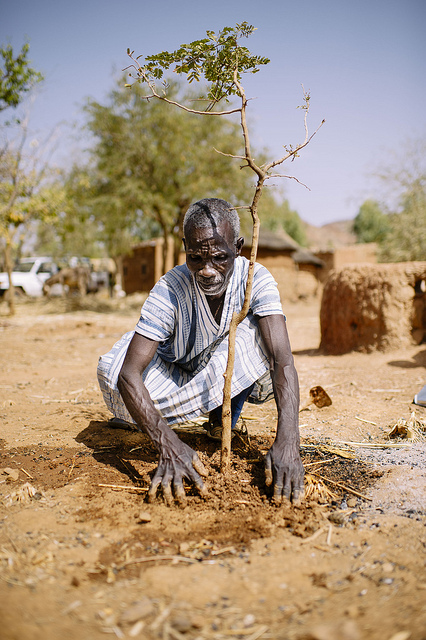
Migration is a valuable adaptation strategy under certain conditions, but when the world’s poorest regions experience crop failures from drought or other climate events, international migration decreases. Why do climate events lead to increased migration in some places, but decreased migration in others?
In “International Climate Migration: Evidence for the Climate Inhibitor Mechanism and the Agricultural Pathway, “ Minnesota Population Center researchers Raphael Nawrotzki and Maryia Bakhtsiyarava show that while some households may use migration as a strategy to diversify livelihoods and buffer against climate vulnerability, among households in West Africa adverse climate events push this important adaptation strategy out-of-reach. Nawrotzki, a postdoctoral associate at the Minnesota Population Center, and Bakhtsiyarava, a second-year Geography student and population studies trainee at the MPC, used Terra Populus data to explore the relationship between climate and migration in rural areas of Burkina Faso and Senegal, and the ways climatic conditions may prevent migration.
Climate Inhibitor Models and the Agricultural Pathway
Nawrotzki and Bakhtsiyarava’s study, recently published in Population, Space and Place, supports the notion that climate may reduce household income, leaving families without the financial means to migrate internationally. This inhibiting effect is likely to be more pronounced in households that depend on agricultural production, as crop yields may change dramatically in response to climate variability and change.
Since 2008, nearly 22.5 million people have reportedly migrated due to climate and weather-related events, according to the United Nations High Commissioner for Refugees. The 2007 Stern report predicts that, as climate conditions worsen, even higher numbers of people will be displaced as they seek refuge from climate-related conflict, crop failures, and rising sea levels. These projections are based on the assumption that climate change drives international migration. Nawrotzki and Bakhtsiyarava say that may be the case sometimes — but not always.
“Migration represents a last-resort adaptation strategy for the world’s poor when their lands become uninhabitable, as in the case of the oft-cited projection that rising sea levels could leave more than one-fifth of Bangladesh under water by the end of the century,“ explains Nawrotzki. “On the other hand, when faced with failed crops, low yields, and declining income, families may lack the capital necessary to sponsor international out-migration.”
This climate inhibitor model was supported by Nawrotzki and Bakhtsiyarava’s study, which examined four climate events: heat waves, cold snaps, droughts, and excessive precipitation. The study showed that a 10% increase in the number of “heat wave” months in Burkina Faso decreased the odds of an international migration by 20%. The authors suggest that this may be related to the climate sensitivity of the agriculture sector. In Burkina Faso, for example, cotton is sensitive to heat stress at temperatures above 28-30 degrees Celsius. An increase in the number of “heat wave” months may have resulted in poor crop yields, and thus less disposable income to finance an expensive international move for a member of the household.
By contrast, years characterized by unusually high rainfall totals in Senegal corresponded with a four-fold increase in the likelihood of international migration. This effect may imply the presence of suppressed migration in years associated with lower rainfall and droughts.
Bakhtsiyarava says, “Senegal relies on groundnut production, and rainfall is an important determinant of groundnut production in many arid climates. Additionally, ground nuts depend heavily on the water stored in the ground and when examining the seasonal effects of rainfall, the study found that higher-than-average rainfalls were most beneficial in the months immediately preceding the growing season.”
Policy Implications
According to Nawrotzki, “Migration is an important livelihood diversification strategy. In the poorest countries, there are not a lot of technologies to guard against the effects of climate change, and the poorer the household, the less able they are to defend against climate events.” Money remitted from family in industrialized nations has become a cornerstone of many of the world’s impoverished countries, and households who have sent a family member overseas benefit from the access to funds – and security – in the event of a crop failure. Without those remittances, families are left to cope with poor crops, food shortages, and ailing health using in situ strategies like borrowing money, selling assets, and accessing over-taxed food assistance programs.
So what does this mean for policy? Financial and administrative supports for migration may decrease vulnerability at the household level by allowing families to dilute their reliance on a single year’s crop yield. Bakhtsiyarava adds that some programs are providing insurance for crop yields to promote resilience among subsistence farmers. Ultimately, Bakhtsiyarava says, “If people are relying on migration for survival, there should be support systems in place to ensure that migration remains a possibility.”
Nawrotzki and Bakhtsiyarava’s study, published in Population, Space and Place, is available via Wiley’s online library.
Story by Jude Mikal
